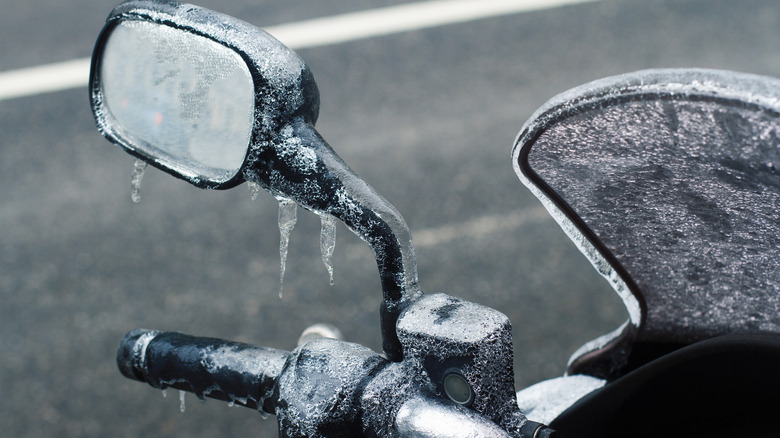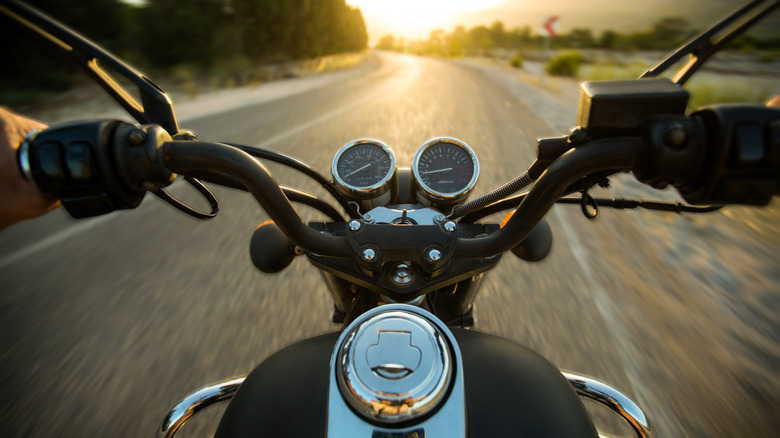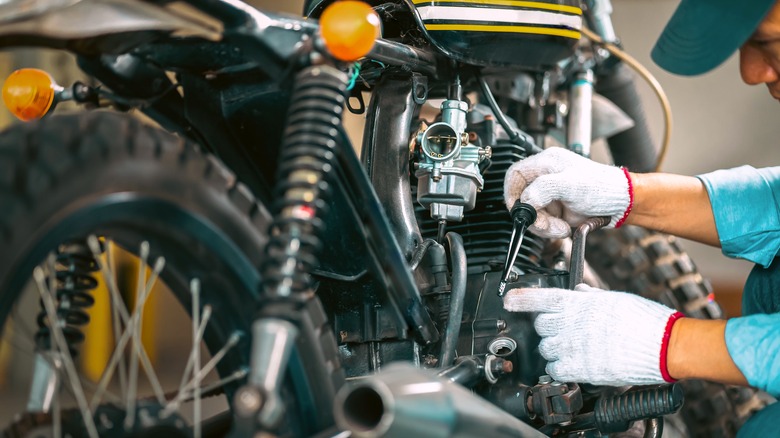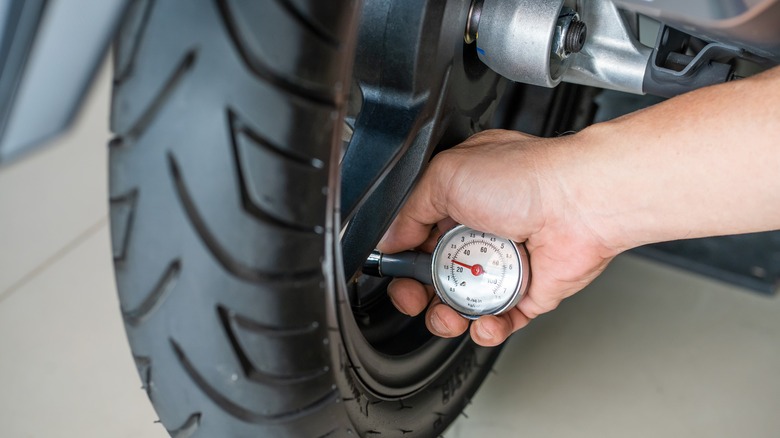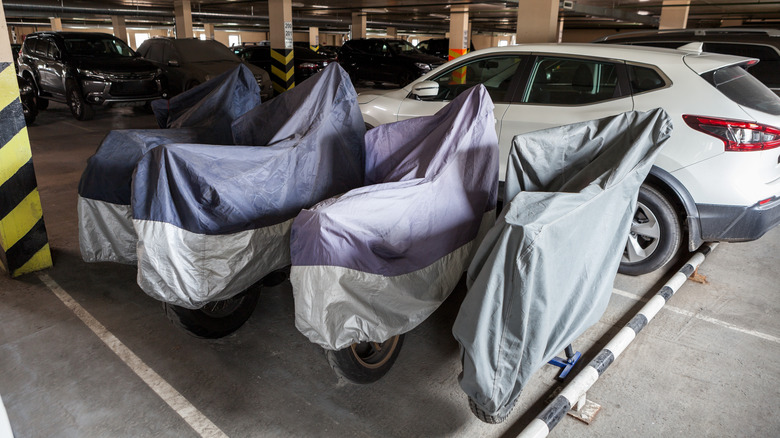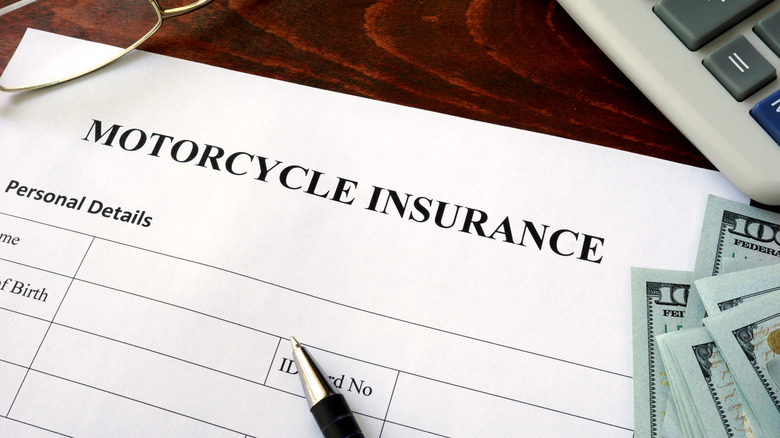5 Tips For Storing Your Motorcycle During The Winter
Plenty of motorcycle enthusiasts live in climates where it's just not feasible to take their bikes out for a ride during parts of (or all of) the winter. Cold temperatures can wreak havoc on motorcycles, which are more vulnerable to the elements than full-bodied automobiles, and other factors like the corrosive nature of rock salt also pose hazards to bikes that are typically not an issue the rest of the year.
As the days become shorter and the nights become colder, at some point, bikers will likely need to put their vehicles aside until the spring. It's important that when they do this, though, they're not just forgetting about their bikes but thoroughly preparing them to endure weeks or months of lying dormant. Otherwise, when it's finally warm enough to start riding again, they may find their motorcycles are no longer in the same condition they were when they were first put away.
There are plenty of things you can do to winterize your motorcycle and prepare it for winter storage, making sure it stays in great shape throughout the months you won't be using it. Here are five tips for storing your motorcycle during the winter.
Take it for one last spin
Before you lock your bike away in storage for the winter months, you should definitely take it out for one last spin on the open road. For one thing, you won't have another chance to do so for potentially months, so you should enjoy the opportunity while you can. But there are more practical reasons you should ride your motorcycle right before storing it away for the winter — including expelling moisture from the exhaust system. Lingering moisture could corrode your muffler and exhaust pipe if left stagnant for months at a time.
You'll want your ride to be longer, not just a lap around the block. By getting your bike's parts up to operating temperature, you can ensure you've expelled all the moisture. Plus, by engaging your brakes several times during the trip, you can help prevent components from sticking while they're inactive during storage, keeping them responsive for when you're ready to roll again.
Finally, a farewell ride is a good way to do one last diagnostic check on your bike. If you notice any issues with your motorcycle during your ride, you can get them fixed over the winter, when you wouldn't be using your bike anyway. That way — when it's warm enough — you can get right back on the road without any delays.
Change your oil and other fluids
You should be changing your oil regularly, but especially before long-term storage. The lubricating and acid-neutralizing properties of motor oil wane over time, so you'll want to make sure fresh oil is doing its job protecting the inside of your engine even when your motorcycle is stored away. Engine oil also absorbs moisture, contaminants, and other combustion byproducts that can damage your bike's internal components, including its rubber seals, while sitting there unattended for a long period of time. Don't forget to use a quality product, like those offered by the best motorcycle oil brands.
Liquids like motor oil — as well as coolant, clutch, and brake fluid — also tend to congeal when left stagnant over time and can pose problems when starting your bike again in the spring. If you haven't changed these fluids in a while, this is the ideal time to do so.
One other liquid you should prepare for winter storage is your fuel. Make sure you top off your bike after that final ride so that your tank is full because an empty fuel tank can corrode and lead to dried-out seals. You also need to make sure you add a fuel stabilizer — without it, the gas in your tank can crystallize and clog your carburetor and fuel injector. Finally, run your motor for a bit so the fuel stabilizer can mix in properly.
Give your tires a check and keep them off the ground if possible
Storing your motorcycle during the winter is a great time to give a once-over to your tires. Make sure they haven't accumulated too much wear and tear since the last time you've replaced them, that enough tread remains on each, and that your wear bars aren't exposed. Of course, you'll also want to check your tire pressure with an accurate, reliable pressure gauge — if you're not sure what the ideal pressure for your bike's tires is, you can check your owner's manual or look up your VIN label online. Cold temperatures can negatively affect tire pressure, and low pressure can hurt the longevity of your tires.
You'll also want to avoid flat spots developing in your tires, which can occur if left in the same position for an extended period. Ideally, you should elevate your bike and keep both wheels off the ground when storing it — if you do elevate it, reduce your tire pressure by 20%. If elevating your bike isn't practical, you should check in on your motorcycle occasionally throughout the winter and move it around so that the same parts of the tires aren't always bearing all of your vehicle's weight. This can also help prevent tire rot.
Keep your bike covered with a quality motorcycle tarp
There's not much point in storing your motorcycle for the winter if you're not storing it properly. Obviously, you'll want to keep it somewhere indoors, like a garage or basement, to protect it from winter weather. Ideally, where you store it will also be a dry, well-ventilated area so that moisture and condensation won't build up between your bike and its cover.
And it should be covered, whether you're storing it indoors or outdoors — especially if it's outdoors. If you're keeping your vehicle in a place like a garage, it may be closer than you'd like to things like fertilizer or other hazardous chemicals that could cause corrosion if they come in contact with your bike. A cover — in addition to protecting your motorcycle from dust, grime, rodents, pets, and other unwanted debris — will help protect it from these more troublesome elements and UV rays if you're keeping it outside or by a window.
You can use blankets or other makeshift covers, but if you can, you should use a high-quality tarp specifically designed for motorcycles. Inferior covers can slip off or, even worse, chafe against your bike's paint job. They can also collect and trap water and potentially cause some damage. Finally, if you're not keeping your motorcycle in a locked storage area, secure it to the tarp and anchor it to the ground, if possible. This can keep both wind and unwanted strangers from removing your tarp (or your bike.)
Don't cancel your motorcycle insurance
It may seem like a prudent move to cancel your motorcycle insurance during the winter, when your bike is off the road and won't be involved in any accidents, but it's not. While you could save some money by skipping a few months of premium payments, it won't be worth it if your insurance does come in handy — and it can, even if your bike is safely stored away.
For one thing, you may decide on a whim to take it out and ride one day. Even the coldest winters have the occasional warm, sunny day, and with the effects of climate change becoming more and more palpable each day, the entire season could be mild enough to warrant using your bike. If that's the case, or if you need to use it last minute in an emergency, you're going to want to make sure it's insured when you do.
Additionally, your bike can still be damaged even while in storage, whether from a winter storm or any other random accident that can happen indoors and out. You're rarely using insurance for something you saw coming, after all. Finally, there's always the chance that your motorcycle can be stolen during the winter. Thieves don't take holidays off, and you may forget to check in on your bike if it's not stored nearby, making it more susceptible to theft. One of the first things you should do if your motorcycle is stolen is contact your insurance, so canceling it during the winter is not a good idea.
